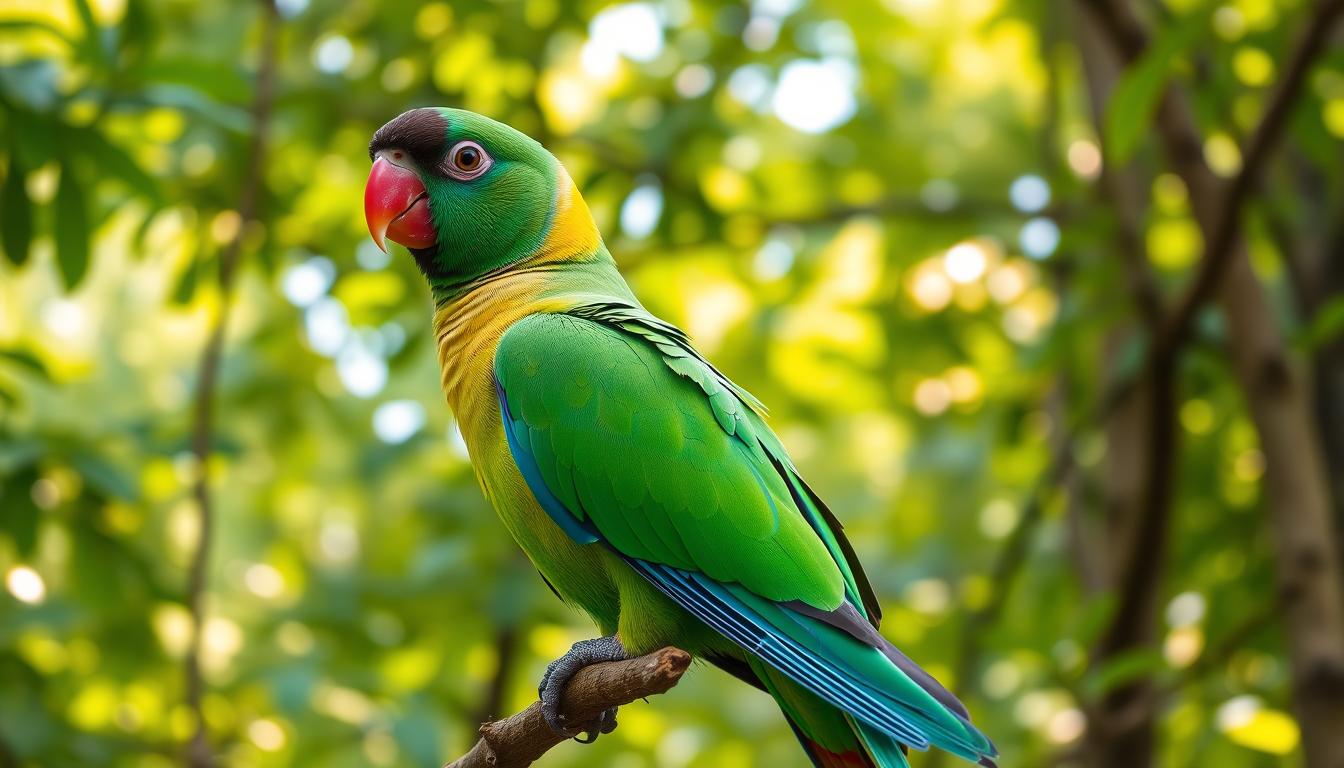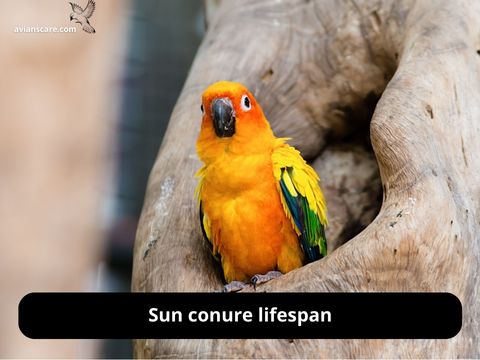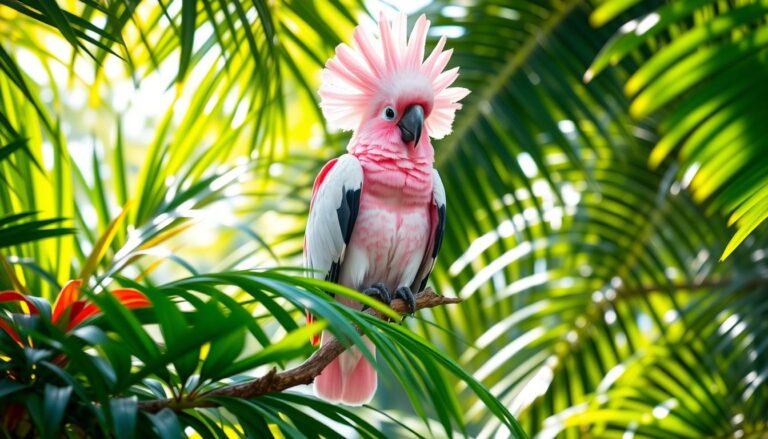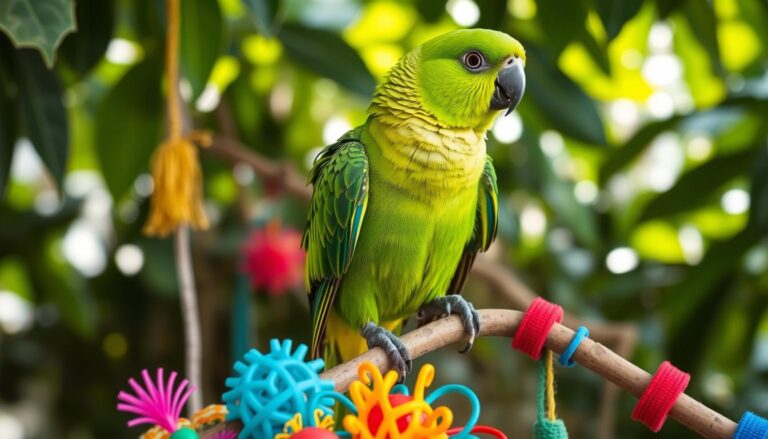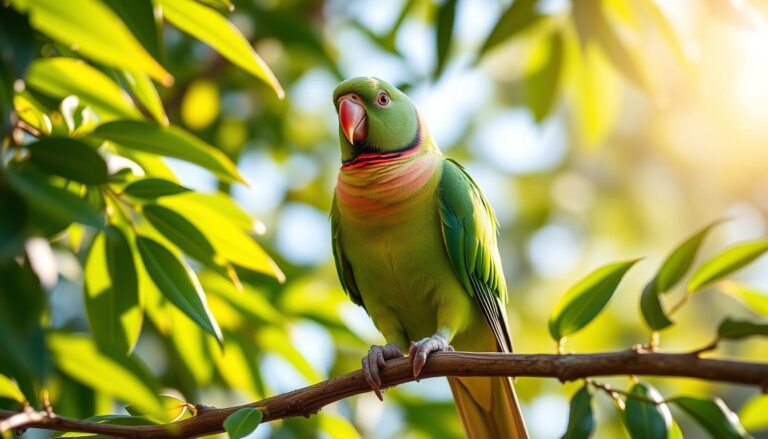Caring for Alexandrine Parakeets: Essential Tips
Caring for an Alexandrine parakeet requires knowing its special needs and traits. This guide offers key tips for both new and current owners. It covers diet, habitat, socialization, and health care to keep your parakeet happy and healthy.
Understanding the Alexandrine Parakeet
The alexandrine parakeet is a colorful and interactive bird. It captivates pet owners with its playful demeanor and high intelligence. It comes from South Asia and is loved for its affectionate nature. Knowing how to care for it is key when thinking about caring for an alexandrine parakeet.
These birds show a range of behaviors that reflect their vibrant personality. They are sociable and thrive in environments where they can interact. Knowing their vocal habits makes for a fulfilling experience, as they communicate energetically. Understanding their social needs helps create an engaging atmosphere, which is vital for their well-being.
The alexandrine parakeet quickly becomes a beloved member of the household with its charming antics and loving nature. Building a connection through interaction and play is essential for bonding. By embracing their lively characteristics, owners can ensure a happy and healthy life for these fascinating companions.
Alexandrine Parakeet Size and Characteristics
The alexandrine parakeet is quite large, reaching up to 18 inches in length. This makes them a medium-sized bird in the parrot family. Their bright green feathers and long tail make them stand out. Males are usually bigger and have more vibrant colors than females.
These birds have strong beaks perfect for cracking seeds and nuts. They have big personalities and need lots of mental and physical activity. It’s important to keep them busy with toys and activities to prevent boredom and bad behavior.
Essential Diet for Alexandrine Parakeets
A balanced diet is key for Alexandrine parakeets’ health. They need a mix of fresh foods, quality pellets, and seeds. This ensures they get all the nutrients for a lively life. Knowing what to feed them helps owners create the best diet plan.
Fruits and Vegetables
Fruits and veggies should be a big part of their diet. They give vital vitamins and keep them hydrated. Some top picks include:
- Apples
- Carrots
- Leafy greens, such as spinach or kale
Offering a variety of colors and textures makes meals fun. It’s also important to wash all produce well. Make sure to remove seeds or pits before giving it to them.
Pellets and Seeds
Pellets and seeds are also important for their diet. They offer protein, vitamins, and minerals. Choose pellets made for parakeets to ensure they get all the nutrients they need. Seeds can add variety but shouldn’t be the main part of their diet.
Water Requirements
They need fresh water every day. Keep their water clean and change it often to keep it hygienic. Use a shallow, non-tip bowl to encourage drinking and prevent spills. Clean water is vital for their hydration and digestion, keeping them healthy.
Creating a Comfortable Habitat
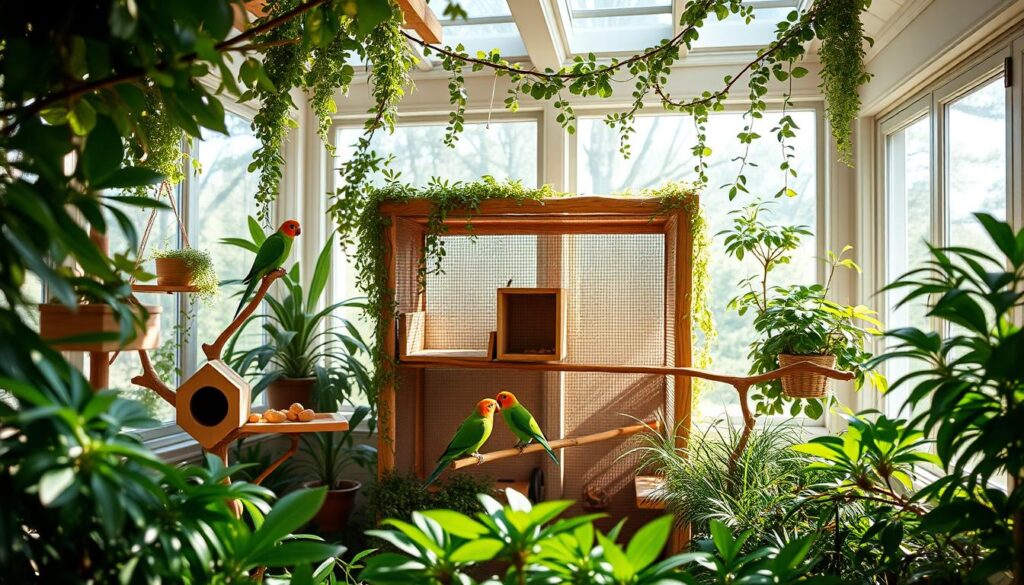
Creating a home for alexandrine parakeets needs careful thought. It’s important to make sure they are comfortable and happy. The cage they live in is a big part of this.
Choosing the Right Cage
Finding the right cage is key. It should be big enough for the bird to move around and exercise. A cage that’s at least 24 x 24 x 36 inches is a good size.
Cages with horizontal bars are great for climbing. This keeps the bird active and healthy. Adding toys and perches at different heights makes the cage even better. Make sure all materials are safe for the bird.
Ideal Location
The cage’s location is also very important. It should be in a place where the bird can see and interact with people. This helps the bird feel connected and happy.
But, it should also be away from drafts and direct sunlight. A stable and quiet spot is best. This helps the bird feel safe and secure.
Socializing Your Alexandrine Parakeet
Socializing an alexandrine parakeet is key for its emotional health. These birds are smart and love to be around people and other birds. Handling them often helps build trust and makes them feel at home.
Playtime is vital for socializing these birds. Playing gentle games or letting them fly helps them feel confident. But, introduce new things slowly to avoid stressing them out.
Having a regular routine that includes time together is important. It helps keep the parakeet and its owner happy. Paying attention to the bird’s body language is also key. It helps you know if they’re comfortable or not.
Training Techniques for Alexandrine Parakeets
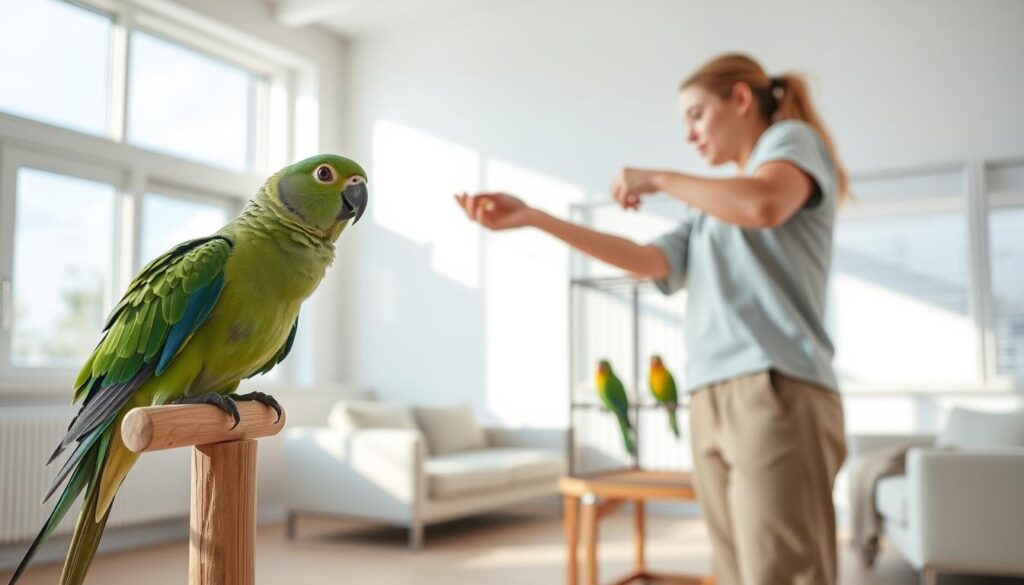
Training Alexandrine parakeets can strengthen the bond between the bird and its owner. Learning basic commands like “step up” and “come here” is key. Positive reinforcement, such as treats and praise, motivates the parakeet to learn.
Basic Commands
Teaching basic commands is vital for parrot training. Here are some tips to make training easier:
- Patience is key during training. Birds may need time to learn.
- Use positive reinforcement to reward good behavior.
- Keep training sessions short and regular to keep the parakeet interested.
- Train in a calm, distraction-free area.
Health Care: Ensuring Longevity
Proper health care is key for alexandrine parakeets to live long and healthy lives. Regular vet visits are important to catch health problems early. It’s best to see an experienced avian vet at least once a year.
These visits help check the bird’s health, including weight and vaccinations. This keeps the bird in top shape.
Regular Vet Check-ups
Regular vet visits help spot health issues early. The vet can check the bird’s behavior, weight, and look for illness signs. This helps owners keep their birds healthy and happy.
Signs of Illness to Watch For
Owners should watch for signs of illness in their birds. Look out for:
- Changes in appetite or drinking habits
- Feather plucking or changes in plumage
- Unusual droppings that differ in color or consistency
- Behavioral changes, such as increased lethargy or aggression
Spotting these signs early can help get medical care quickly. This boosts the bird’s chances of getting better and staying healthy.
Understanding Alexandrine Parakeet Lifespan
The lifespan of an alexandrine parakeet can range from 15 to 30 years. Several factors affect this, including genetics, diet, and care. It’s important to think about this long-term commitment before getting an Alexandrine parakeet.
To help an alexandrine parakeet live longer, it’s key to keep its life quality high. This means reducing stress with good housing and social time. A diet full of nutrients is also vital for health and longevity.
Keeping the bird engaged and happy can also extend its life. By focusing on these areas, you can greatly improve your parakeet’s well-being.
Choosing the Right Alexandrine Parakeet for Sale
When looking for an alexandrine parakeet, health and ethics are key. It’s important to find a reputable breeder. A good breeder will show you the bird’s health records and let you see where the birds live.
Finding Reputable Breeders
To make a good choice, do your homework. Here are some tips for finding trustworthy breeders:
- Look for breeders who are members of recognized avian associations.
- Read reviews from previous customers to gauge satisfaction and credibility.
- Seek personal recommendations from other bird owners or local pet stores.
- Visit breeders in person to assess the living environment and treatment of the birds.
- Ask questions about their breeding practices and health testing.
By following these steps, you’ll have a better chance of getting a healthy parakeet. This will make your time together more enjoyable. Remember, finding a good breeder is key to a happy bird and owner.
Variations: The Violet Yellow Alexandrine Parakeet
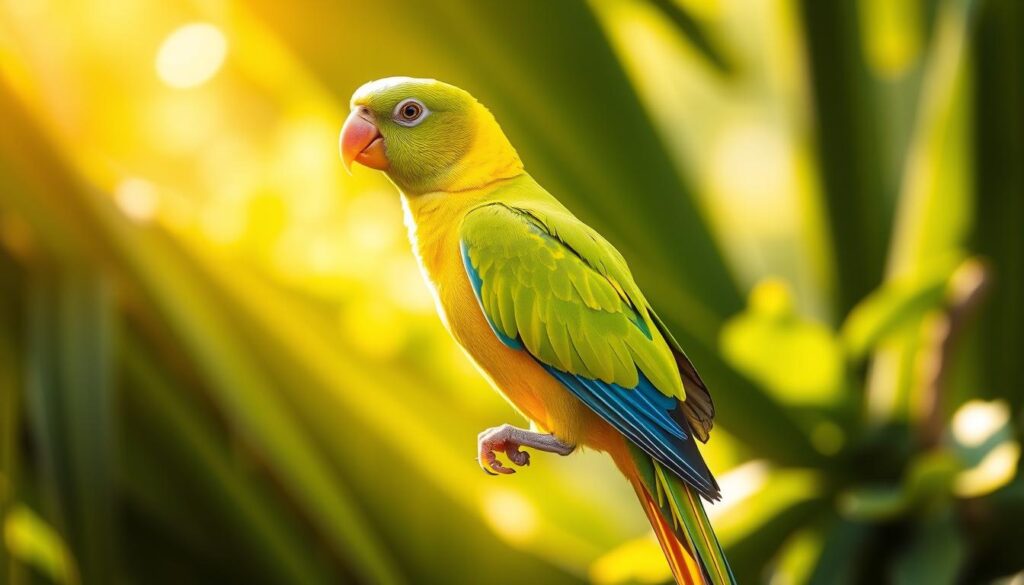
The violet yellow alexandrine parakeet is a unique variation of the Alexandrine species. It has a stunning mix of violet and yellow feathers. This makes it a hit among bird lovers.
It’s important for owners to give these birds the right food. They need high-quality pellets, fresh fruits, and veggies. This keeps their feathers bright and their health good. Regular vet visits are also key to check for any health issues linked to their color.
Creating a good home for the violet yellow alexandrine parakeet is vital. They need big, airy cages with lots of toys. They also need plenty of light and social time to be happy and live long.
Alexandrine Parakeet Price Considerations
The price of an alexandrine parakeet can change a lot. This is because of the bird’s age, color, and the breeder’s reputation. Usually, people pay between $300 and $1,000. Birds that are younger or have special colors cost more. Birds from famous breeders also have a higher price because of their care.
When thinking about getting an alexandrine parakeet, remember the costs don’t stop at the bird itself. You’ll also need to pay for food, vet visits, and a good cage. These monthly expenses can add up quickly. So, it’s important to include them in your budget before you bring the bird home.
Being ready for the costs of owning an alexandrine parakeet makes for a happier experience. Knowing all the costs helps you give your bird a happy and healthy home. This way, you can enjoy your time together without worrying about money.

